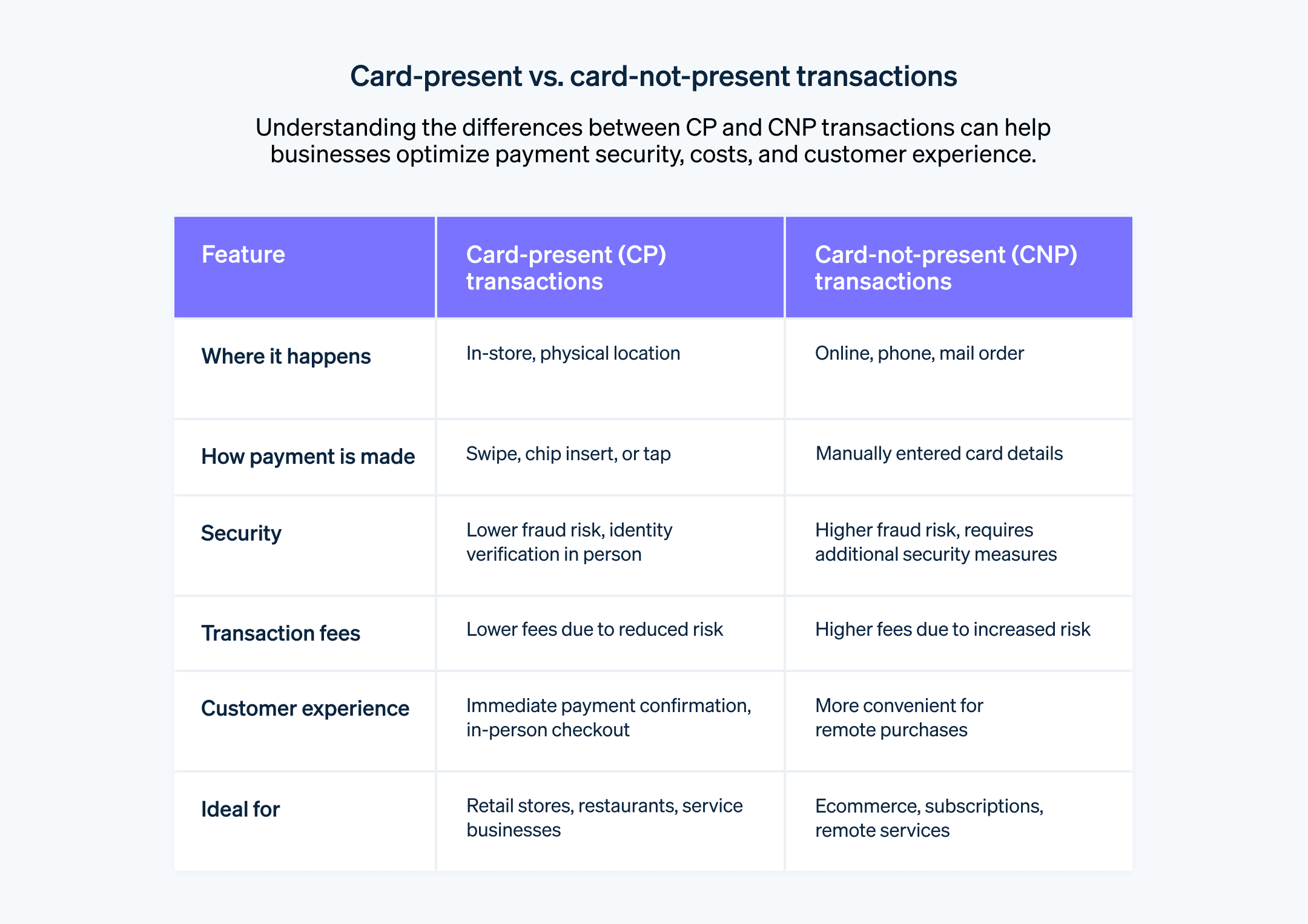预计 2023 年全球电子商务销售额将接近 6 万亿美元,可见无卡 (CNP) 交易已成为许多企业交易组合中的重要组成部分。然而,有卡 (CP) 交易仍在一些拥有实体店的企业中扮演着重要角色。企业需深入了解这两种交易类型,以衡量其优势、潜在挑战及适合性,从而为自身选择最合适的交易方式。
本文将介绍有卡和无卡交易的区别,分析其各自的特点,并探讨企业如何评估并选择适合的选项。同时,我们还将说明支付处理提供商在此决策过程中的作用,以及这些合作伙伴在帮助企业应对复杂支付环境方面的优势。
目录
- 什么是有卡交易?
- 有卡交易的优势和挑战
- 什么是无卡交易?
- 无卡交易的优势和挑战
- 有卡交易 vs. 无卡交易:如何选择最适合您的业务的方式?
什么是有卡交易?
有卡 (CP) 交易是指持卡人在销售点向商家出示其实物信用卡或借记卡的支付方式。大多数情况下,这种交易发生在实体店,顾客通过刷卡、插卡或轻触卡片在读卡器上完成交易。
有卡交易的显著特点是持卡人和支付卡片均在场,使得商家能够实时验证交易的有效性。有卡交易通常使用电子读卡器或销售点 (POS) 终端读取卡片信息,并常需持卡人签字或输入 PIN 码以完成交易。
有卡交易的优势和挑战
有卡交易是日常商业活动的基础,也是消费者在店内购物时最常用的交易类型。与其他交易方式一样,有卡交易也有其自身的优点和挑战,企业需要了解。
优势
增强安全性
有卡交易的主要优势之一是安全性较高。由于持卡人和卡片在场,销售人员可以核实持卡人身份,从而降低欺诈性交易的可能性。较低的交易成本
由于有卡交易的风险较低,其处理费用通常低于无卡交易,随着时间的推移,这可以为企业节省大量成本。即时支付处理
有卡交易可以实时处理,企业可立即收到支付成功的确认,这意味着交易完成迅速,提升顾客的购物体验。
挑战

什么是无卡交易?
无卡 (CNP) 交易指的是在线、电话或邮购交易,在此类交易中,持卡人在支付时不会向商家出示实体卡片。这种情况下,商家需依赖顾客提供必要的卡片信息(如卡号、有效期和 CVV 码)来处理支付。
由于缺乏实体卡验证,这类交易的欺诈风险更高,因此通常需要额外的安全措施,如地址验证服务 (AVS) 或安全码的使用。
无卡交易的优势和挑战
随着数字化和远程业务的发展,无卡交易越来越普遍。这种方式推动了全球商业的发展,让顾客无需亲临实体店即可随时随地完成购买。然而,这类交易也有固有的风险,尤其是欺诈可能性增加。企业应充分了解无卡交易的优缺点,以便有效管理此类交易。
优势
扩大市场范围
无卡交易打破了地理限制,使企业能够服务全球客户,从而显著扩展客户群并增加潜在收入。提升客户便利性
无卡交易让顾客可以随时随地购物,优化了整体购物体验。降低运营成本
维护实体店需支付租金、水电费和员工工资等各类开销,而无卡交易通常需要较少的资源来管理,有助于降低成本。增加销售机会
无卡交易为企业提供了更多的销售机会,如在线冲动购物、追加销售和交叉销售,这些在实体店环境中较难实现。
挑战
更高的欺诈风险
由于交易中无法确认持卡人身份,商家更难验证顾客身份,从而提高了欺诈交易的风险。更高的处理费用
由于无卡交易的风险较高,支付处理商通常会对此类交易收取更高的费用。客户信任问题
由于交易是远程进行的,客户可能会对提供卡片信息的安全性存在疑虑,可能会影响转化率。争议和撤单的风险
无卡交易更易发生争议和撤单,部分原因是顾客无需亲临实体店即可完成购买,无法现场确认所购买的商品。
随着越来越多的商业活动转移到线上,无卡交易变得越来越普遍且必要。企业在考虑这种交易方式时需全面评估其带来的机会和挑战。成功管理无卡交易的关键在于降低风险并最大化收益,比如实施完善的欺诈预防机制,并选择可靠的支付处理商来提供安全的无卡交易处理服务。
有卡交易 vs. 无卡交易:如何选择最适合您的业务的方式?
在选择有卡和无卡交易时,企业应考虑其更广泛的运营模式和客户期望。
有卡交易通常与实体店相关,顾客或销售人员在终端上刷卡、插卡或感应卡片完成支付。而无卡交易则随着电子商务的兴起而普及,因为在交易点并不涉及实体卡片,顾客直接输入支付信息。对于许多企业,尤其是既有线上销售又有线下销售的企业来说,这并非二选一的问题。通常,混合方式才是最佳选择。
这两种交易方式的主要区别在于它们处理客户数据、交易费用和欺诈预防需求的不同。有卡交易费用较低,但可能将业务限制在实体店内,还需要投资于 POS 设备。无卡交易则让企业能够全球拓展市场,但由于欺诈风险更高,需更强大的安全基础设施。
选择交易方式应与您的业务规模、目标受众和销售环境相一致。如果您经营的是本地精品店或餐厅,有卡交易可能更适合您的业务。而如果您运营的是电子商务网站或订阅业务,目标客户来自不同地域,无卡交易可能更符合您的运营需求。
对于拥有多个销售渠道的企业,如实体店和在线购物的结合,拥有能够高效处理两种交易类型的支付处理方案至关重要。关键在于基于您的统一销售策略,找到合适的组合,而非选择其中一种。
与可靠的支付处理商合作,做出明智的支付选择至关重要。支付处理商可以基于行业经验提供宝贵的建议,提供符合企业需求的可扩展解决方案,并帮助企业保持合规,解决安全问题。
最终,优化支付流程在于了解有卡和无卡交易的关键差异以及它们对业务的影响。这些考虑因素将帮助您提升交易效率,同时改善整体客户体验。
本文中的内容仅供一般信息和教育目的,不应被解释为法律或税务建议。Stripe 不保证或担保文章中信息的准确性、完整性、充分性或时效性。您应该寻求在您的司法管辖区获得执业许可的合格律师或会计师的建议,以就您的特定情况提供建议。